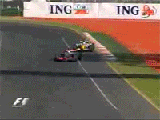The 2004 study:
http://www.aeromech.usyd.edu.au/15afmc/ ... C00191.pdf
I mentioned on the first page targets a subject many members have referred to in this thread. The interaction between the wheel and front wing. I'll offer a quote:
"Figure 3 shows that there was a large pressure acting at the base
of the cylinder near the front of the contact patch, as well as
behind the rear contact patch. Over the top of the cylinder, a
lower pressure exists and because of this, a spinning cylinder in
contact with the ground generates lift.
Figure 3. Coefficient of Pressure Contour plot for a cylinder.
This high pressure region is not confined to just the front contact
patch of the cylinder, but also extends forward. Another
important feature that is evident from the Coefficient of Pressure
contour plot (fig 3) is the separation point that is located slightly
forward of the top of the cylinder.
Aerofoil and Cylinder Pressure Coefficients
The high pressure region forward of the front contact patch that
was discussed earlier (figure 3) was also evident in results
obtained for the aerofoil and cylinder case (figure 4). This high
pressure region acts on the bottom surface of the aerofoil and for
this reason the aerofoil was generating lift as opposed to the
desired downforce. This could potentially be the reason why the
front wings on F1 cars have had a reduced span after the
regulation changes imposed for the 1998 season. The regulation
changes required that the maximum width of the car be reduced
from 200cm to 180cm and this would have further increased the
interaction between the front wheel and wing.
Similarly, this is the reason that the aerofoil was experiencing a
forward force, or a negative drag, in most positions tested in the
presence of the cylinder. As the angle of attack was increased ..."



